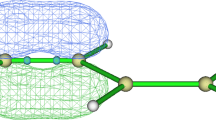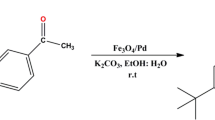Abstract
The reaction energies of one cis-fused and four new trans-fused benzene dimers have been studied with state-specific multi-reference Møller-Plesset perturbation theory of the second order (MRMP2) based on reference CASSCF(12,12) wavefunctions. The cis-fused dimer 1, the product of symmetry-allowed [4 + 2] cycloaddition process, has been previously characterized experimentally and theoretically and, in this study, was used as reference. Dimer 1 lies 45 kcal/mol above two isolated benzene molecules, and its retro-dimerization activation energy is ~ 8 kcal/mol. In contrast, the [4 + 2] formation of trans-fused dimer 2 is symmetry-forbidden with an energetic driving force (Erel) of 57.6 kcal/mol. An activation barrier for corresponding retro-dimerization calculated to be 31.0 kcal/mol. The thermal [2 + 2] formation of dimers 3 and 4 are also symmetry-forbidden. They have been calculated to be 79.0 kcal/mol and 105.1 kcal/mol higher in energy than two isolated benzene molecules, respectively. However, the activation energies of 23.2 and 20.5 kcal/mol could allow for kinetic persistence of these compounds. Dimer 5 is the only symmetry-allowed [2 + 2] cycloaddition product. With Erel of 67.5 kcal/mol and Ea for retro-dimerization reaction of 19.2 kcal/mol, it shows high similarity with the symmetry-forbidden dimers. The wave function for each of the dimers at their local minimum geometry contains greater than 80% of the configuration \(\sigma^{4} \pi^{8} \sigma^{*0} \pi^{*0}\). The transition state for the retro-dimerization of 1 (1TS) also contains more than 80% of the closed-shell configuration \(\sigma^{4} \pi^{8} \sigma^{*0} \pi^{*0}\). For 2TS–5TS systems, the wavefunctions exhibit significant biradical character (20%, 20%, 14% and 26%, respectively).








Similar content being viewed by others
Notes
Theoretical work on hexaprismane and p,p'-dibenzene.
Theoretical work on o,o':p,p'-dibenzene also discussed in Ref. 3(c) and 3(d).
Experimental observation of o,o':p,p'-dibenzene.
Experimental observations of o,o':o,p'-dibenzene.
Possible derivatives of o,p':p,o'-dibenzene.
Theoretical works on anti-o,o'-dibenzene and syn-o,o'-dibenzene. See also references 3(b) and 3(c)
Experimental works on anti-o,o'-dibenzene and syn-o,o'-dibenzene.
Theoretical works on dimer 1. See also references 3(c), 3(d) and 13.
Experimental works on dimer 1.
Throughout this work, we have used the “heavy dot” notation for H-atoms above the ring plane. As explained in [13], this notation has great utility for describing a large array of benzene dimers differing in stereochemistry just by the placement of the protons. We are aware that this notation is “strongly deprecated” by IUPAC.
The notations [2+2] and [4+2] correspond to the well-known pericyclic nomenclature. Throughout this work, the use of 's' and 'a' subscripts are also derived from the pericyclic reaction nomenclature.
References
Woodward, R. B., Hoffmann, R., Angew. Chem., Int. Ed.1969, 8, 781.
Diels O, Alder K (1928) Justus Liebigs Ann Chem 460:98
Engelke R, Hay PJ, Kleier DA, Wadt WR (1983) J Chem Phys 79:4367
Engelke R, Hay PJ, Kleier DA, Wadt WR (1984) J Am Chem Soc 106:5439
Schriver GW, Gerson DJ (1990) J Am Chem Soc 112:4723
Wang Y, Li Z, Wang F, Sun C (2009) Phys Chem Chem Phys 11:455
Yang NC, Horner MG (1986) Tetrahedron Lett 27:543
Martin, H.-D., Pfohler, P., Angew. Chem., Int. Ed.,1978, 17, 847
Martin H-D, Pfohler P, Urbanek T, Walsh R (1983) Chem Ber 116:1415
Kostermans GBM, van Dansink P, de Wolf WH, Bickelhaupt F (1987) J Am Chem Soc 109:7887
Cometta-Morini C, Baumann H, Oth JFM (1992) J Mol Struct (Theochem) 277:15
Cometta-Morini C, Baumann H, Oth JFM (1992) J Mol Struct (Theochem) 277:31
Röttele H, Martin W, Oth JFM, Schröder G (1969) Chem Ber 102:3985
Berson JA, Davis RF (1972) J Am Chem Soc 94:3658
Yang NC, Hrnjez BJ, Horner MG (1987) J Am Chem Soc 109:3158
Noh, T., Gan, H., Halfon, S., Hrnjez, B. J., Yang, N. C., J. Am. Chem., Soc.1997, 119, 7470
Schroeter K, Schröder D, Schwarz H, Reddy GD, Wiest O, Carra C, Bally T (2000) Chem Eur J 6:4422
Engelke R (1986) J Am Chem Soc 108:5799
Quenneville J, Germann TC (2009) J Chem Phys 131:024313
Braun R, Kummer M, Martin H-D, Rubin MB (1985) Angew Chem Int Ed 24:1059
Bertsch A, Grimme W, Reinhardt G (1986) Angew Chem Int Ed 25:377
Moss GP (1996) Pure Appl Chem 68:2193
Rogachev AYu, Wen X-D, Hoffmann R (2012) J Am Chem Soc 134:8062
Hirao K (1992) Chem Phys Lett 190:374
Hirao K (1992) Chem Phys Lett 196:397
Hirao, K., Int. J. Quant. Chem.,1992, S 26, 517
Hirao K (1993) Chem Phys Lett 201:59
Perdew JP, Burke K, Ernzerhof M (1996) Phys Rev Lett 77:3865
Perdew JP, Burke K, Ernzerhof M (1997) Phys Rev Lett 78:1396
Adamo C, Barone V (1999) J Chem Phys 110:6158
Neese, F., The ORCA program system, Wiley Interdiscip. Rev.: Comput. Mol. Sci., 2012, 2, 73.
Dunning TH Jr (1989) J Chem Phys 90:1007
Neese F, Wennmohs F, Hansen A, Becker U (2009) Chem Phys 356:98
Granovsky, A. A., Firefly version 8.0.1, https://classic.chem.msu.su/gran/firefly/index.html
Schmidt, M. W., Baldridge, K. K., Boatz, J. A., Elbert, S. T., Gordon, M. S., Jensen, J. H., 36. 36. Koseki, S., Matsunaga, N., Nguyen, K. A., Su, S., Windus, T. L., Dupuis, M., Montgomery, J. A., J. Comput. Chem., 1993, 14, 1347.
Granovsky AA (2011) J Chem Phys 134:214113
Nakano H (1993) J Chem Phys 99:7983
Rintelman JM, Adamovic I, Varganov S, Gordon MS (2005) J Chem Phys 122:44105
Bofill JM, Pulay P (1989) J Chem Phys 90:3637
Pulay P, Hamilton TP (1988) J Chem Phys 88:4926
Bone RGA, Pulay P (1992) Int J Quant Chem 45:133
Wiberg, K. B., Cyclobutane – Physical Properties and Theoretical Studies. In The Chemistry of Cyclobutanes. Ed. by Rappoport, Z., Liebman, J. F., John Wiley & Sons, Ltd, Chichester, UK, 2006.
Bernardi F, Bottoni A, Robb MA, Venturini A (1990) J Am Chem Soc 112:2106
Acknowledgements
Financial support from Illinois Institute of Technology (start-up funds, A.Yu.R) and partial support from the Wanger Institute for Sustainable Energy Research (WISER) Seed Grant (A.Yu.R) are gratefully acknowledged.
Author information
Authors and Affiliations
Corresponding author
Ethics declarations
Conflict of interest
The authors declare no competing financial interest.
Additional information
Publisher's Note
Springer Nature remains neutral with regard to jurisdictional claims in published maps and institutional affiliations.
Electronic supplementary material
Below is the link to the electronic supplementary material.
Rights and permissions
About this article
Cite this article
McNeely, J., Rogachev, A.Y. New benzene dimers: an MRMP2 study. Theor Chem Acc 139, 87 (2020). https://doi.org/10.1007/s00214-020-02598-9
Received:
Accepted:
Published:
DOI: https://doi.org/10.1007/s00214-020-02598-9




